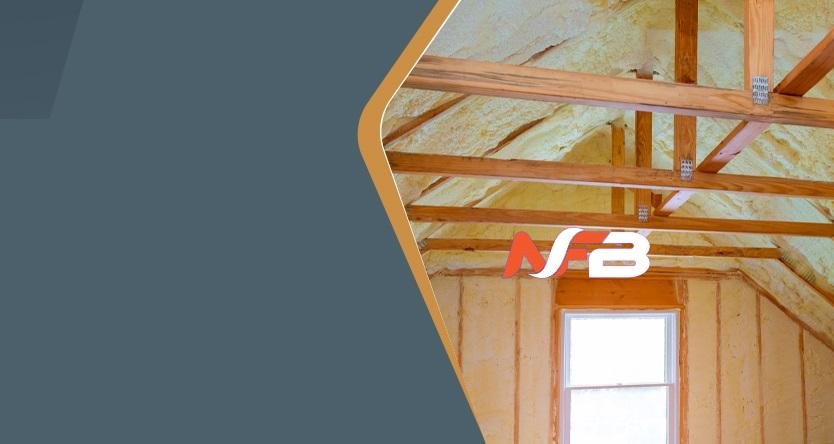When it comes to making your home more energy efficient, one of the most impactful improvements you can make is adding insulation to your loft.
Loft insulation creates a thermal barrier that prevents heat from escaping in winter and keeps out heat in summer, helping to regulate your home’s temperature and reducing energy costs.
But how exactly does loft insulation provide these benefits? Understanding factors like R-values and thermal performance is key to choosing the right insulation for your home.
What is an R-Value?
The effectiveness of insulation is measured in terms of its R-value. R-value represents a material’s capacity to resist heat flow – the higher the R-value number, the better the insulation. R-value is measured as units of ft2°Fhr/Btu – the amount of heat energy in Btu that’s transferred through 1 square foot of the insulation material.
The higher the R-value, the greater the insulative effectiveness of the material. Loft insulation typically has an R-value of anywhere from R-10 to R-60 or more. Building regulations set minimum recommended R-value requirements for insulation in attics/lofts based on climate and location, typically around R-30. However, adding extra insulation beyond this minimum will improve efficiency further. InsulationPoint mentioned that there is no maximum limit to the viable R-value of attic insulation, so higher numbers within budget constraints are better.
Read Also:- Home Builders in Utah County
How R-Values Works
The key to understanding R-value is recognizing that thermal heat energy is transferred in three primary ways: conduction, convection, and radiation. The ability of insulation to resist each of these types of heat transfer determines its overall R-value.
Conduction is the direct transfer of thermal energy by molecular activity within a continuous solid or liquid mass. Materials like metal that are good heat conductors have lower R-values. Insulation materials with tiny air pockets or fibers full of dead air space impede conductive heat flow, increasing R-value effectively.
Convection is the transfer of heat by movement of liquids and gases. Insulation limits air movement and circulation, restricting convective heat transfer. Higher density insulation products have smaller air gaps, limiting convection more than loose fluffy ones. Adding vapor barriers can also reduce convective impacts.
Radiant heat transfers via electromagnetic energy waves. Some insulation contains reflective elements like foil facing which reflects radiant thermal energy, increasing resistance to radiative heat flow. Fibrous insulation also scatters and absorbs radiant energy waves that would otherwise be transmitted through air spaces.
Understanding Thermal Transfer and Resistance
Insulation works by introducing resistance to conductive, convective, and radiant heat flow across materials. Air is naturally an excellent insulator – its inherent thermal resistance is why double-glazed windows full of air gaps offer good insulation. Filling spaces with bad conducting materials containing pockets of trapped air maximizes thermal resistance and minimizes heat loss/gain.
The density, thickness, and geometric shape of insulation products impacts resistance values. Adding more inches of insulation depth increases the length of heat flow pathways and the number of air gaps to transfer across, boosting thermal resistance. The combination of insulative material and depth determines the ultimate R-value performance.
Insulation shapes thermal transfer routes by forcing heat to take more indirect pathways. Instead of moving straight out through ceilings, lofts force heat on zig-zag journeys through millions of fibers and air pockets. Like a maze or obstacle course, the longer and more convoluted the route, the lower and slower the heat passage, cutting down thermal transfer.
Insulations Performance Factors
Beyond basic R-values, several other interacting factors impact insulation system efficiency. Installation quality is crucial – gaps, compression, and insufficient depth severely degrade thermal performance. Air leakage and moisture management also affect functionality.
Insulation forms a system with ceilings, attic spaces, ventilation gaps, and air/moisture barriers. Proper installation depth and density must be maintained across coverage areas. Compression where insulation is packed down too tightly or gaps where areas are missed both drastically lower R-value.
Likewise, air leakage via cracks, joints, fixtures, and unfinished spaces enables airflow that can reduce insulative effectiveness through convection. Sealing areas fully helps maximize performance. Vapor barriers are also vital in attics to prevent moisture accumulation that can damage insulation or reduce functioning over time.
Considering all these dynamics in total building envelope systems is necessary to model real-world R-values and thermal conductivity through loft spaces. Lab tested R-values only reflect single material samples – managing installation and environmental factors holistically improves true long-term thermal resistance.
Insulation Types and R-Value Differences
Not all insulation is made equal when it comes to thermal resistance and R-value stability over time. Different insulation materials have distinct performance attributes based on composition and structure. Key loft insulation types in the UK include:
- Glass Wool – Made from recycled glass formed into a fine fibrous mat or batt form, with typical R-values ranging from R-13 to R-32.
- Stone Wool – Fibers formed of volcanic rock or smelted slag, available as batts, boards, and loose forms, from R-16 to R-45.
- EPS Foam Boards – Rigid foam boards of expanded polystyrene plastic beads, with R-values as high as R-60.
- XPS Foam Boards – Extruded polystyrene closed-cell rigid foam with R-25 to R-50 values.
- Natural Fiber Products – Made from cellulose, sheep’s wool, hemp and other fibers offering R-13 to R-47 performance when properly installed at correct densities.
- Sprayed Foam Products – Applied as liquid reactive foams expanding to fill spaces, typically polyurethane or polyisocyanurate foams, up to R-50.
Read Also:- Home Entertainment Space with Style and Technology
Maximizing Loft Insulation Benefits
The primary goal in insulating lofts is slowing heat flow to regulate interior home temperatures for comfort and energy savings. R-values measure insulation’s ability to achieve this based on quantified resistance to conductive, convective and radiant thermal transfer.
Choosing insulation batts, boards, blankets or sprays with the highest viable R-value within budget, combined with professional installation at proper coverage depths, gives you the best thermal performance over time. Monitoring insulation condition and loft air sealing also ensures insulating value is maximized across all seasons.
Properly designed and managed loft insulation systems cut heat gain/loss substantially. The Department of Energy claims adding R-30 attic insulation can lower home heating/cooling costs by up to 20 percent annually in the average UK home. The science behind increased thermal resistance shows that higher insulation R-values reliably boost energy efficiency and savings for homeowners.















Leave a Reply